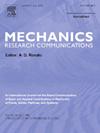气动载荷作用下二维翼型冰断裂行为及影响因素研究
IF 2.3
4区 工程技术
Q3 MECHANICS
引用次数: 0
摘要
飞机在飞行过程中经常遇到结冰和脱落冰,对飞行安全构成严重威胁。为了研究气动载荷作用下翼面积冰断裂脱落的机理,基于键合周动力理论建立了翼型冰断裂脱落的数值模型。采用计算流体力学方法得到了冰外表面的气动载荷分布,并将其作为边界载荷作用于冰周动力学模型的外颗粒层,以预测裂纹的起裂和扩展行为。冰是由过冷的大水滴结冰形成的,形成了公羊角的形状。分析了入流速度、迎角、冰弹性模量和冰临界粘结拉伸对翼型冰断裂行为的影响。该模型有效地预测了裂纹的起裂时间、位置、扩展路径和扩展速率。低入流速度下,不产生裂缝;然而,当速度超过临界阈值和攻角增大时,高应力区域更容易出现裂缝。此外,较低的弹性模量和断裂韧性显著加速了裂纹的形成和扩展。该研究为飞机防冰系统的设计提供了理论基础和技术参考。本文章由计算机程序翻译,如有差异,请以英文原文为准。
Investigation of two-dimensional airfoil ice fracture behavior and influencing factors under aerodynamic loading
Aircraft frequently encounter icing and ice shedding during flight, which poses a serious threat to flight safety. To investigate the fracture and shedding mechanisms of ice accumulation on the wing surface under aerodynamic loads, a numerical model for the fracture and shedding of airfoil ice is established in this paper based on the bond-based peridynamics theory. The aerodynamic load distribution on the outer surface of the ice is obtained using the computational fluid dynamics method and applied as a boundary load to the outer particle layer of the peridynamics model to predict crack initiation and propagation behavior. The ice is formed by the icing of supercooled large water droplets, resulting in a ram’s horn shape. The effects of inflow velocity, angle of attack, ice elastic modulus, and ice critical bond stretch on the fracture behavior of airfoil ice are analyzed. The model effectively predicts the crack initiation time, location, propagation path, and propagation rate. Under low inflow velocity, no cracks were generated; however, as velocity exceeds a critical threshold and the angle of attack increases, cracks are more likely to develop in high-stress regions. Additionally, a lower elastic modulus and fracture toughness significantly accelerate crack formation and propagation. This study provides a theoretical foundation and technical reference for the design of aircraft ice protection systems.
求助全文
通过发布文献求助,成功后即可免费获取论文全文。
去求助
来源期刊
CiteScore
4.10
自引率
4.20%
发文量
114
审稿时长
9 months
期刊介绍:
Mechanics Research Communications publishes, as rapidly as possible, peer-reviewed manuscripts of high standards but restricted length. It aims to provide:
• a fast means of communication
• an exchange of ideas among workers in mechanics
• an effective method of bringing new results quickly to the public
• an informal vehicle for the discussion
• of ideas that may still be in the formative stages
The field of Mechanics will be understood to encompass the behavior of continua, fluids, solids, particles and their mixtures. Submissions must contain a strong, novel contribution to the field of mechanics, and ideally should be focused on current issues in the field involving theoretical, experimental and/or applied research, preferably within the broad expertise encompassed by the Board of Associate Editors. Deviations from these areas should be discussed in advance with the Editor-in-Chief.

 求助内容:
求助内容: 应助结果提醒方式:
应助结果提醒方式:


